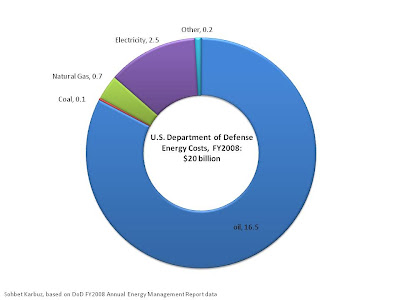The US Military Energy Consumption in 2008
Finally! The U.S. Department of Defense released its FY2008 Annual Energy Management Report. I don’t know why the report was delayed 3 months. What I don’t understand, in fact, why DESC still hasn’t published its Factbook for FY2008.
FY2008 Annual Energy Management Report, as usual, hides the vital information. If you want to get the big picture you have to do your own calculations. The whole report, in my opinion, is kind of attempting to validate some famous sayings about statistics, like “statistics are like bikinis. What they reveal is suggestive, but what they conceal is vital,” and “Do not put your faith in what statistics say until you have carefully considered what they do not say.”
Renewables, energy efficiency, how well the DoD did to reduce its energy consumption etc cover 99.9% of the report. BUT it does not give you a real fact based summary, not even in “Executive Summary.”
So, I decided to prepare three charts based on the data provided, as usual, at the end of the report.
1. The DoD site delivered energy consumption in Fiscal Year 2008 was 890 trillion Btu. In 2007, it was 865 trillion Btu. Note that the figures refer to site delivered energy consumption. A better metric is primary energy consumption. If looked from that angle DoD energy consumption indeed is 1138 trillion Btu.

2. Anyway, let me go ahead with site delivered energy consumption (which is the preferred metric by the DoD). Almost 75% of site delivered energy was consumed by tactical vehicles; 23% in buildings, and slightly over 1% in energy intensive or exempt facilities and by nontactical vehicles respectively.
3. Jet fuel is still the king. It accounted for 56% of total DoD site delivered energy consumption. Add other oil types, you get 76%. Another 11% for electricity and 8% for natural gas. Oh, I forgot, share of renewables is negligible.
4. Money, money, money: DoD hit a new record in FY2008. It spent $20 billion for energy. (79% of which for tactical vehicles, 19% for buildings, and less than 3% for the rest). Or better, over 80% for mobility, and 20% for installations.

5. Yes, $20 billion: Mostly for oil ($16.5 billion, followed by electricity, $2.5 billion)
 6. DoD oil consumption in terms of barrels per day: 350,000
6. DoD oil consumption in terms of barrels per day: 350,0007. Average cost per gallon of jet fuel in FY2008: $3.12
8. Average cost of electricity: 6 US cent per kWh. Question: what is the average cost of electricity produced from renewable energy sources? Well, not indicated in the report. It is hidden behind the numbers. Or I missed.
9. Conclusion: DoD is and will remain the single largest energy consumer in the world.
a. DoD should get over with its renewable energy mania and try to look at where its biggest pains are. Just read the points above.
b. DoD should answer the following question: How much money is spent for renewable energy? How much renewable energy is used? How much conventional energy supposedly saved? What are the costs and savings per unit of energy?
10. Still open questions: How many installations, e.g. building are privatized? How many utility services have been outsourced? How many/how much transport service has been given to contractors? Why aren’t they included in DoD energy consumption?
posted by sohbet karbuz @ 10:51 PM





Nessun commento:
Posta un commento